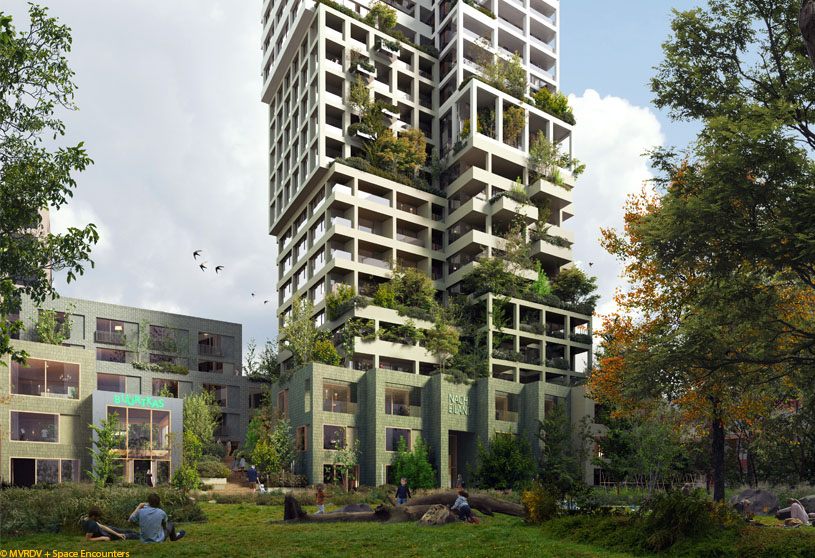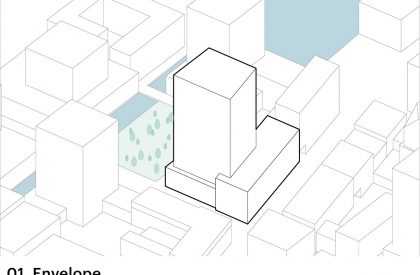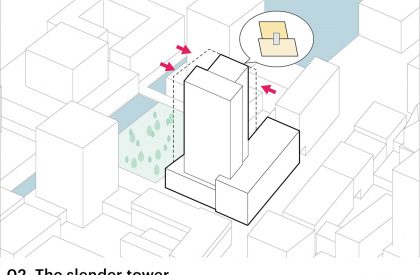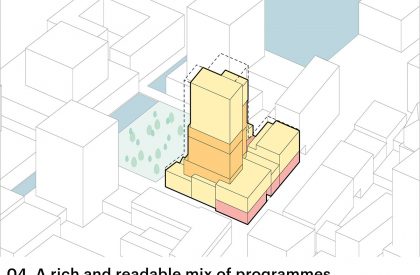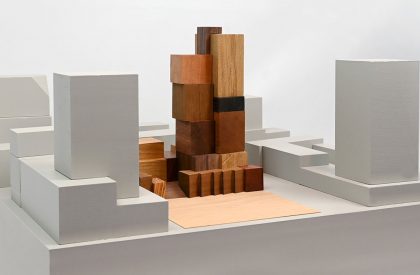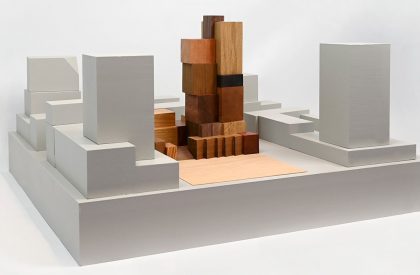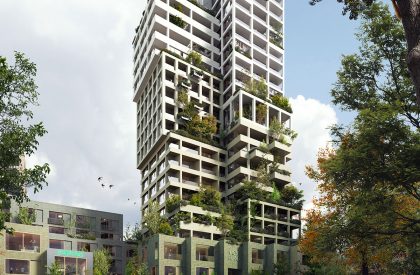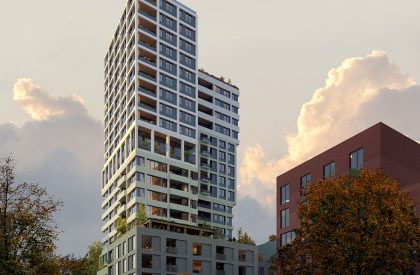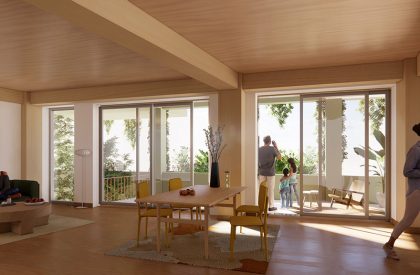Excerpt: Nachteiland, an energy-positive architectural project by MVRDV and Space Encounters, centres on concepts of sustainability and greenery. The building’s form, which consists of a series of blocks that together function as a collection of distinct neighbourhoods, reflects the project’s varied array of apartments and retail space. These blocks are arranged vertically to form the tower above and side by side to form the plinth at ground level.
Project Description

[Text as submitted by architect] This energy-positive timber-hybrid tower will strengthen the community in an under-construction Amsterdam neighbourhood. MVRDV and Space Encounters have won the competition to design a 22-storey residential tower in Amsterdam’s Sluisbuurt neighbourhood. Working in close collaboration on all parts of the design, the team of two architecture offices have proposed a building with a wooden structure, energy- producing façade, and abundant green and communal spaces.
The project aims to set an example in an under-construction neighbourhood that has sustainability and greenery as its core principles. The project provides 153 homes – including 60 reserved for mid-sector rental – with a focus on apartments catering to urban households, helping to address shortfalls in Amsterdam’s current housing provision.

Officially called Nachteiland – meaning “night island” in Dutch, in reference to the work of choreographer Rudi van Dantzig after whom the neighbourhood’s main street is named – the building is designed for the real estate partnership of LOCUS Real Estate Development and Miss Clark.
Located at the heart of the Sluisbuurt, between Rudi van Dantzigstraat and a small pocket of greenery, the project’s diverse range of apartments and retail is expressed in its visual appearance: the shape of the building is composed of a series of blocks which act as like a collection of different neighbourhoods. These blocks are positioned side-by-side at ground level to form the plinth, and vertically to form the tower above.


Along Rudi van Dantzigstraat, the plinth is constructed out of blocks of three to six storeys, echoing the sizes of neighbouring buildings and hosting a series of double-height spaces for shops and cafés. On the side of the pocket park, the plinth is broken up even further to create a series of townhouses, which are punctuated in the middle by a communal greenhouse and a broad green staircase that extends the greenery upwards to a first-floor courtyard in the heart of the plot.


The tower rises to 70 metres, built up of blocks that gradually increase in size towards the top of the tower. with varying facades and outdoor spaces to underline the diversity of apartments within. With the lower half containing the project’s mid-sector rental properties, offering excellent access to the communal rooftop spaces which top the plinth.
Many of these rooftops feature pergolas supporting solar panels, allowing accessible spaces where relaxation coexists with energy generation. The façade of the tower features a different type of solar panel, using building-integrated photovoltaics (BIPVs) that combine solar energy generation with a tasteful green finish.
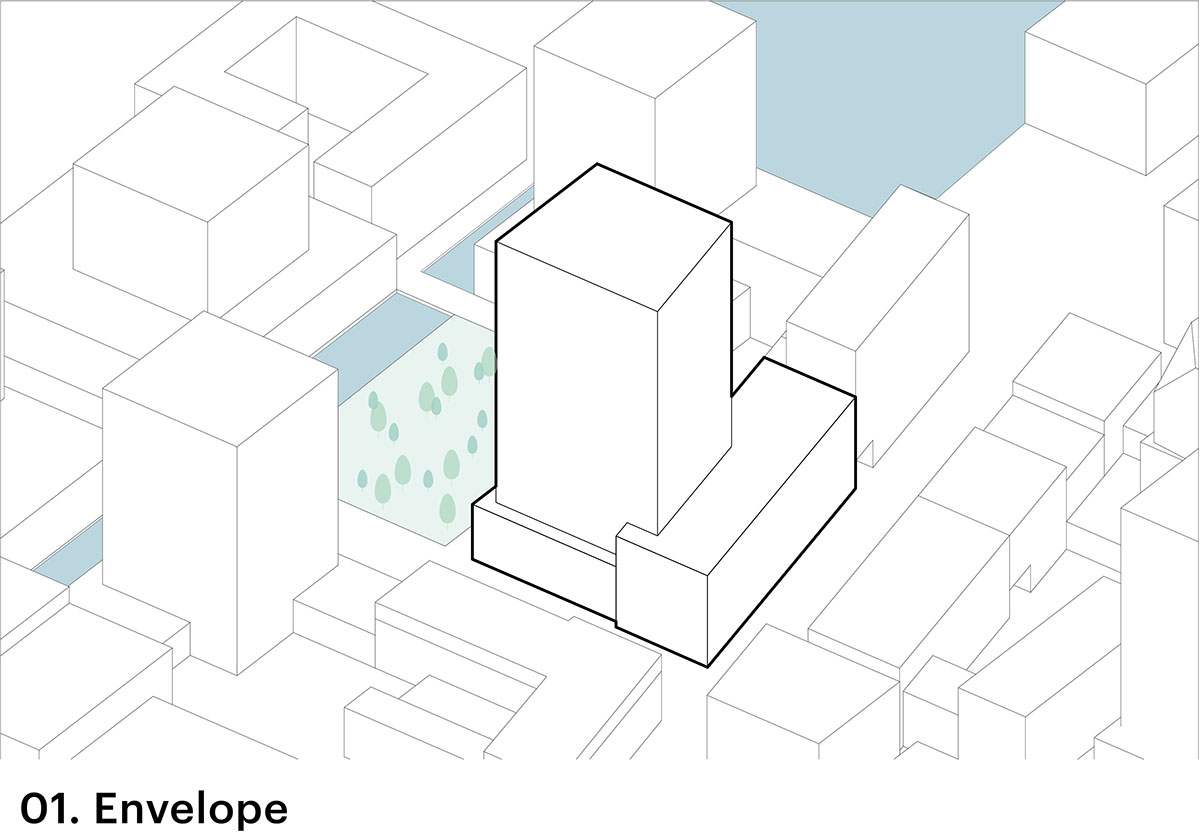
The design references the neighbourhood’s location with complementary east and west façades. Seen from the east, with central Amsterdam as the backdrop, the building is relatively urban and formal in appearance; from the west, the building is more segmented and adorned with greenery, hinting at the smaller, low-rise homes and the green fields that lie beyond, to the northeast of Amsterdam.


“This project is a demonstration that in addressing our housing crisis, sustainable design doesn’t need to be a ‘nice-to-have’ – it can be central to the design itself”, says MVRDV founding partner Jacob van Rijs. “As one of the most visible projects within this new neighbourhood, we are excited to set the benchmark for what can be possible in a community where greenery and sustainability are the central principles.”
“We succeeded in making a tower that sets a new unique mark in the Sluisbuurt, showing different faces from different perspectives”, says Joost Baks, founding partner of Space Encounters. “It’s inspired by an art piece created by Joost Baljeu in 1978, which has this same quality. In this way, the view of the tower shifts between a sharp urban silhouette and a vertical green stepped landscape.”

The project sets ambitious targets for energy production and consumption. Tall buildings are often difficult to make energy-neutral due to their relatively low roof surface area available for solar panels. However, in the case of Nachteiland, the building-integrated photovoltaics more than make up for the difference. The building is therefore energy-positive, producing 3.03 kilowatt hours per square metre per year more than it uses (a BENG 2 rating of -3.03).

Calculations for both bio-based and circular-economy materials show a similarly exemplary approach. The structure of the building will be constructed almost entirely with wood, using concrete only in the structural core and the columns of the tower up to the sixth floor. As a result, 61 percent of the building’s materials will be bio-based, while 13 percent will be recycled. Combined with the project’s demountability strategy these measures give the building a Building Circularity Index (BCI) score of 61 percent.
Nachteiland was designed by MVRDV and Space Encounters for developers LOCUS Real Estate Development and Miss Clark. The project team includes Delva Landscape as landscape architect and Dura Vermeer as contractor.
